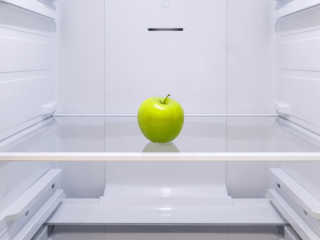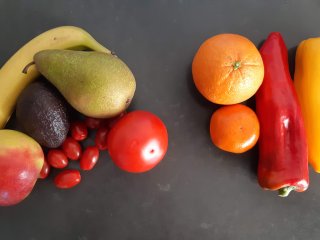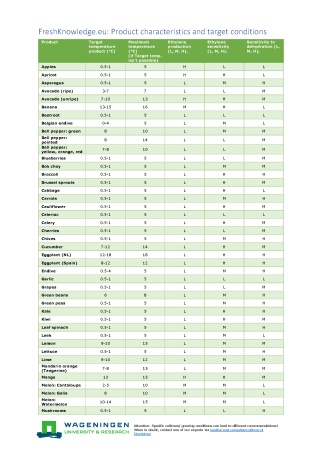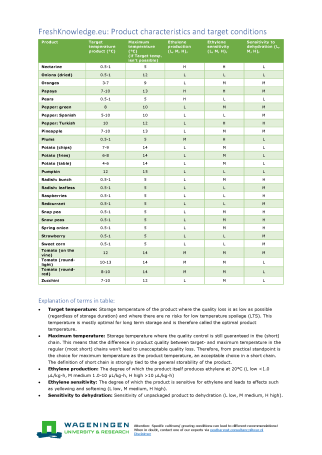
Conditions and product characteristics
Vegetables, fruit and flowers react differently to conditions in the chain such as temperature, ethylene and humidity due to all kinds of properties. It is therefore essential to store fresh products under the appropriate conditions to preserve the best possible quality. On this page we provide an overview of the most important product properties and target conditions for each fruit and vegetable, such as temperature, degree of ethylene production and sensitivity, and sensitivity to drying out.
Directly to

Target temperature
A product is best stored at the optimum temperature (target temperature). Conditions that are too cold can lead to damage. While in conditions that are too warm, the product ripens faster and can therefore spoil and dry up faster. The target temperature is therefore usually the lowest possible temperature at which the product will not be damaged, even if it is kept at this temperature for a longer period of time. A too low temperature often presents risks for longer storage. Read more about controlling temperature here.

Ethylene sensitivity
Just like a high temperature, the gas ethylene can also cause products to ripen and age more quickly. This also depends on the ethylene sensitivity of a product. This property differs per product. It is wise not to store products with a high ethylene sensitivity with products that produce ethylene. In practice, an ethylene inhibitor or blocker is sometimes used to reduce ethylene production in the products.

Sensitivity to dehydration
The sensitivity of a product to water loss/dehydration is also an important property that determines which condition is desired to best maintain quality. Products with high susceptibility to dehydration should be stored in a high relative humidity environment and proper packaging should be used to prevent weight loss and maintain product quality. Read more about controlling humidity conditions and protecting against dehydration here.

Product charateristics and target conditions
The table below describes important storage conditions and properties of about 65 products in the chain: the target and maximum temperature (°C), the ethylene production and ethylene sensitivity and the sensitivity to dehydration.
The table has been compiled on the basis of available knowledge from scientific and professional literature from the Netherlands and abroad. However, insufficiently substantiated information is available for many products. That is why extensive use has been made of expert knowledge, partly consisting of years of practical and research experience. For some products, a target temperature for conditioning has been established on the basis of similar products. Of course, specific cultivars and growing conditions can also lead to deviating recommendations or cultivars require specific conditions. The list gives both target and maximum temperatures. This always refers to product temperatures and not ambient temperature!
The table has been compiled on the basis of available knowledge from scientific and professional literature from the Netherlands and abroad. However, insufficiently substantiated information is available for many products. That is why extensive use has been made of expert knowledge, partly consisting of years of practical and research experience. For some products, a target temperature for conditioning has been established on the basis of similar products. Of course, specific cultivars and growing conditions can also lead to deviating recommendations or cultivars require specific conditions. The list gives both target and maximum temperatures. This always refers to product temperatures and not ambient temperature!


Examples of use of condition table for mixed storage
-
If you store broccoli at 1 °C, and a batch of mandarins comes in, can you put them in a cold store with the broccoli?
No, rather not because the mandarins are sensitive to chilling injury, the target temperature is 7-12 °C, while for broccoli the maximum temperature is 5 °C. Whichever temperature you choose, it always comes at the expense of product quality: either the mandarins run the risk of cold damage, or the broccoli ages faster than desired. -
Pears and broccoli have the same target temperature (0.5-1 °C), can they be kept together in the cold store?
No, better not. Pears produce a lot of ethylene (production=high), while broccoli can react strongly to this (ethylene senstivity=high). When stored together with pears, the broccoli can yellow faster. -
Raspberries and garlic have almost the same conditions and characteristics, only raspberries are more sensitive to dehydration (M) than garlic (L). Can they be stored together?
Variation in sensitivity to desiccation is usually overcome by custom packaging design and is thus usually not a problem in conditioning. What is a problem is that garlic has a strong odor that can be transferred to products such as berries or apples. That is why storing raspberries and garlic together is not a good idea. -
I receive strawberries that go with an unrefrigerated transport tomorrow. If I now place them at the target temperature (0.5-1 °C), a lot of condensation will occur during transport, so it is better to place them at the maximum temperature of 5 °C, right?
No, in general it is better to store the strawberries at a lower temperature with risk of condensation than to raise the temperature to avoid condensation.